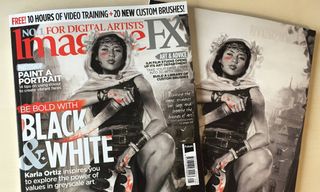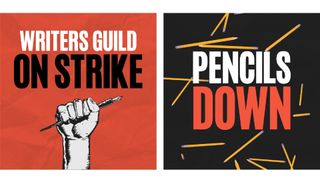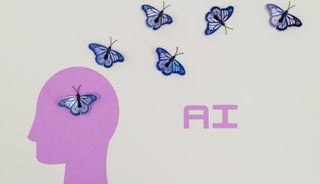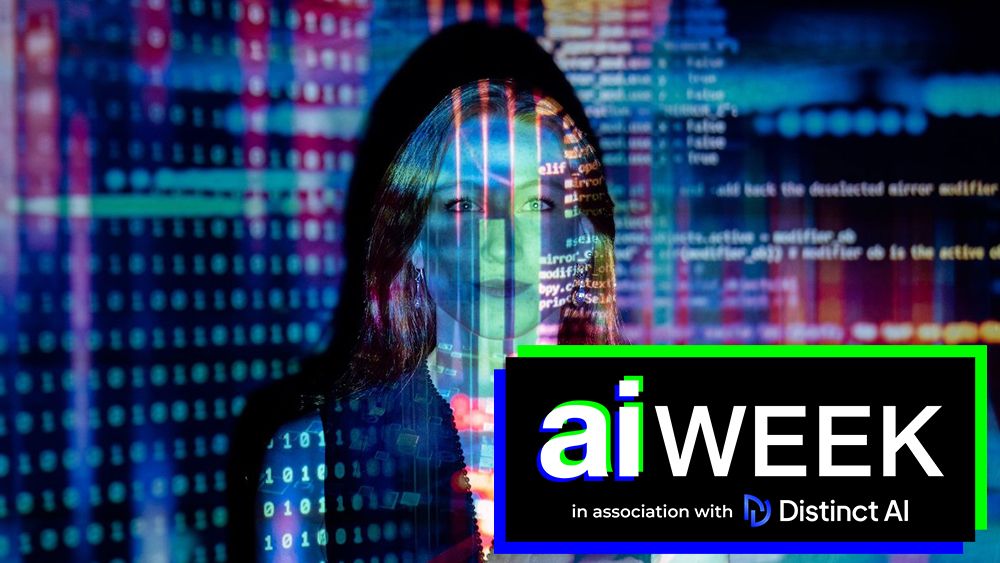What’s the future of AI art? It’s a big question and one that’s on the minds of many creatives. Predicting the future of AI is dangerous since it’s evolving rapidly, but it does seem that whether we like it or not, it’s impact on all sectors and that includes art.
From a technical perspective, no one can fail to be impressed by what AI can produce and how quickly it’s improved. At the same time, anyone who creates art for a living and doesn’t very dependable, bankable style or niche probably feels threatened, partly due to the fear they may lose work to AI and party for the fear that best AI art generators may learn to replicate their style with not regard for intellectual property rights.
We spoke to a number of creative professionals to survey their opinions on the future of AI art and how they think it may affect their work. If you want to learn more, see our piece what is AI art? and the history of AI art. We’ve also explored how creatives are using AI in art to augment their workflows.
“These systems are based on theft”
Florida-based creative director and product designer Matthew Gallagher speaks for many when he says: “I’m worried about the rise of generative AI in every capacity and its negative effect on those in my profession to earn a living, as well as the damage it’s already doing to the industry. It’s long been the case that anyone who can hold a pencil believes they are an art director. Now with the ability to merely enter a prompt, anyone is now capable of delivering some sort of completed image.”
Matthew knows the industry well: he’s spent 35 years working as an employee, contractor, and consultant for companies like The Walt Disney Company, Hallmark, IBM, Viacom, MLB and NFL. And he believes that the impact of AI on the creative profession cannot be underestimated. “These systems are based on the theft of not only my work, but millions of artists, photographers, illustrators, product designers and others. And they’re being used to generate new works, with no recognition nor recompense for the original creator.”
Matthew argues that not only is this immoral, it’s also illegal and criminal. “Most websites, including those that showcase artwork, have specific contractual language that forbids the deconstruction of the site and its content to create something new,” he points out. “Site owners spend time, effort, and money to create their business model and want to ensure their interests are protected. Wholesale scraping content by AI tools is, at its core, a violation of laws, contracts, and the user agreements of almost every site they pull data from to train their large language models.”

He believes, there is nothing positive about the rise of the use of AI image generators. “Nothing that is created through theft, on this scale, can be beneficial to artists, the industry, nor society in general,” he argues. “Art is the culmination of time, tears, effort, craft, etc, of the artist and once completed is a moment in time, based on a host of parameters of their lived experience. To cheapen that by an automaton that spits out lifeless drivel, collaged together from the blood, sweat, and tears of a million other artists does not create new art, it merely shits out faeces. Both stink, but at least you can use manure to grow roses whereas nothing good comes from a Generative AI output.”
Can AI art be stopped?
So what’s to be done? Matthew is speaking out through his social and business networks, and supporting the class-action lawsuit brought by artists Sarah Andersen, Kelly McKernan and Karla Ortiz against Midjourney, Stability AI and DeviantArts. he’s also been investigating the use of tools like Glaze to protect his work from theft and misuse, although he notes that this increases the amount of time to create and deliver work to the market. The ‘anti AI’ social media platform Cara plans to integrate Glaze into its app.
Rob Skelly, associate creative director at Leeds agency Born Ugly, takes a similar view to Matthew. “There has to be a level of integrity in how AI is used,” he argues. “Getty Images has already started a legal case against Stability AI, and more will follow before stricter regulations come in. Scraping data for training isn’t necessarily an infringement of copyright, but how the data is used certainly could be. It could be compared to a ‘human’ designer looking at an artist’s work as a source of inspiration versus copying the piece of art and claiming it as their own.”
More broadly, Matthew believes, “the industry needs to be guided by the creative community with whom they wish to work. They need to recognise fair compensation and credits to the artists used in their LLMs [large language models] to date, as well as a means for individuals and companies to remove their intellectual property from the source code. There needs to be an opt-in for any use of work going forward and a means to recognise and compensate those that choose to participate with these companies and their generative tools.”
He thinks the US Federal Government needs to step in too. The European Union has passed legislation to require AI content to be labelled as such, but the US has yet to advance. “They should ensure that these companies do not breach private networks in a rush to grow their LLMs and hold those accountable of breaking their respective laws,” he says. “Future government regulations will be needed to ensure not only an equitable industry for customers, but that there is no single dominant player owning this market and eliminating competition.”
Music industry parallels
But the million dollar question is… will any of this actually happen? Matthew points to a time when sampling in the music industry was carried out without crediting or compensating the artist. Then came the lawsuits…
“And eventually the industry and their lawyers came to an mutually beneficial agreement to enable these new derivative works, while also compensating and recognising the original creators. Right now, the Writers Guild of America is striking due to many issues, but widely discussed is the use of AI in Hollywood’s writing process and its detrimental effects on the creative process.”

The way that the music sampling issue was settled does, indeed, give hope that artists and AI giants can reach a similar understanding. But perhaps a more apt parallel from the music industry might be the rise of illegal song sharing via Napster in the 1990s and 2000s.
Because while the big music companies successfully sued and shut down Napster, thousands of similar sites continued to pop up. And that eventually let to the decimation of what was once known as the ‘record industry’, which has never truly recovered its profitability and cultural influence since.
Just to put things in perspective, Napster was a small site run by a few young upstarts. In contrast, today’s AI juggernaut is now backed by billion-dollar tech giants including Microsoft and Google. That doesn’t mean it’s unstoppable, of course. But it does mean that artists wishing to protect their interests have a fight on their hands, to say the least. You can read more about the artist fightback against AI in our article What can be done to stop generative AI art?.
Should creatives be worried about AI art?
Ultimately, even the best-case scenario for artists and illustrators is probably going to involve some job losses. But what about creatives as a whole: should everyone be worried? The reality is that the worth of much AI art is dubious. While smaller businesses may decide that it’s ‘good enough’ for their needs, many will not want to risk being tarnished by it.
Speaking to people up and down the industry, a sense of cautious optimism appears to be holding. “Truly original content is something only humans can create,” reasons Dan Bacon, executive creative director at 20ten, a creative agency based in central London. “The ability to create truly original content, to think of something one minute and paint it the next, to see a storyboard frame and then light it in reality, and to then make someone cry in a cinema seat is something that only we can retain. AI doesn’t have that lens.”
Rose Stewart, design director at London consultancy The Frameworks is also looking on the bright side. “I think AI will become more and more prominent, and equal parts an empowering tool for designers and something we need to keep in check,” she says. “One thing I’m interested to see is whether, as it evolves, there will be a heightened inclination towards authenticity and something being created by real people. As AI becomes more prominent in design I can see a power in being able to say this was made by hand, by a person, by real materials, genuine techniques, for example, especially in art.”

Emma Jones, senior designer at Reading marketing agency onebite, offers a similar take. “My personal belief is that AI will never replace professional designers, developers, videographers and photographers, but it will help to create a new generation of ‘AI Prompt Producers’,” she says. “Professionals will always be needed to push quality and detail. We can’t run from AI, so we must learn to work with it. And actually, the creative potential that ‘co-creating’ could unleash is something I’m very much looking forward to being a part of.”
Are humans that special?
This was a message I heard loud and clear when researching this article: a sense of disbelief that AI software, however sophisticated, will ever match the creativity of a real-life person. But Gavin MacArthur, creative director at immersive experiences company Pixel Artworks, sounds a note of caution.
“It seems a very human trait to overestimate the importance of the human mind in the creative process,” he says. “We say that machines can’t be creative, maybe not in the same way as us, but machines may be able to follow very similar paths to achieve creative output. They won’t use their senses to explore a world before creating something new, but AI will have access to a digital library vastly greater than what any one person can experience. It will very likely create content that the end user simply can’t distinguish whether it was made by a human or machine. And will the audience even care if that experience moves them?”
That doesn’t make Gavin a doomsayer, though: “The creative industry isn’t under threat from AI,” he believes. “But specific roles or tasks that are currently done by humans are likely to be picked up by machines, as we’ve seen with copywriting and ChatGPT.” And like Emma, he believes that’s something we simply can’t run from. “It’s part of the constant evolution of technology and how our industry can embrace and embed it in the creative process,” he argues. “The skill and creative balance are knowing how to use AI and where it will achieve the desired impact.”
Impact on artists
So should artist and illustrators start looking for another job? Well, maybe not everyone needs to panic just yet. Rebecca Dell, a senior art agent at London illustration agency The Different Folk says that currently, she’s not worried about AI impacting her artists’ ability to earn… precisely because of some of the issues Matthew mentioned.

“Given the lack of legal clarity on copyright and limitations of AI at present, I don’t see our clients shifting away from working with artists to using AI,” she explains. That said, Rebecca notes that her agency is focused larger-scale commercial projects with big brands, and believes smaller clients with limited budget may well be tempted to use AI as a cost-cutting measure.
“This could have a significant impact on young, underrepresented artists who typically use smaller commissions to fund themselves in the early years of their careers” she says. “Jamie Njoku-Goodwin, chief executive of UK Music, said recently on Channel 4 News that ‘AI can only generate not create’, and I think that’s an important distinction.
“Our artists create art that comes from a human perspective, whereas AI can only generate imagery based on previous references. Longer term though, who knows? It’s important to keep an eye on the changing dynamics and watch how it may affect pricing, usage and client expectations.”
At the same time, AI is opening up new creative jobs, or expanding the scope of certain jobs. Rehab is a creative agency with its own AI consultancy. It believes that the real power of AI at the moment is not in producing final creative output, but at the very beginning of the creative process, for digesting data, investigating trends and audiences and generating ideas. Its found Tim Rodgers says this can give artists and designers new skillsets, expanding their ability to carry out research.
A legal minefield
Like others, though, Rebecca is worried about AI art algorithms learning from her artists’ art, and aping their style without compensating them.
“Our artists each have unique portfolios that stand out in the creative field, so if AI was generating new work in their styles and offering it to clients at significantly reduced rates, this would be a huge concern,” she says. “From our perspective it would be a significant breach of their copyright. And we’d take legal action just as if another artist were tracing someone’s work.”
On the plus side, she notes, “Platforms which compensate artists for using their imagery would be interesting as some artists may choose to participate in AI as an additional revenue stream, similar to how they may upload imagery to stock websites.”
All this points to one overwhelming conclusion: for good or ill, the future of AI art is largely going to lie in the courts. With artists, illustrators and their representatives lining up to take on the tech giants, it’s sobering to think that a few judges may have the power to determine the entire future of the creative industry through their decisions.
We’ll be watching events closely at Creative Bloq, and we’ll be covering developments in AI from all sides.
See our round up of the best AI art tutorials to learn about how AI art generators work.
